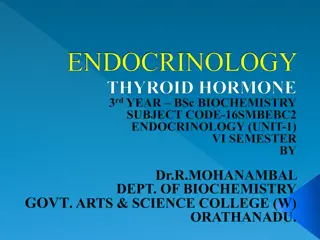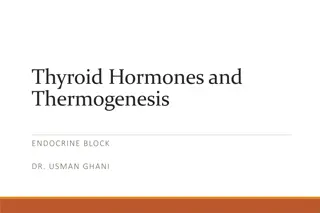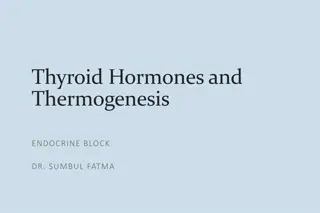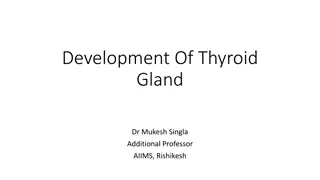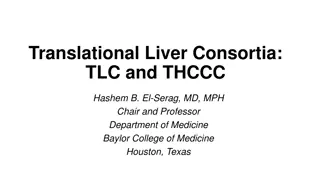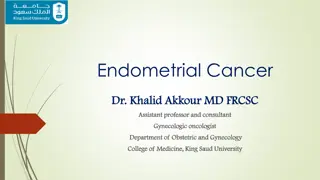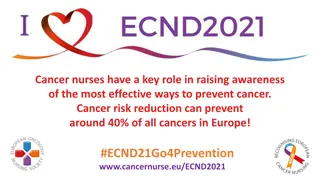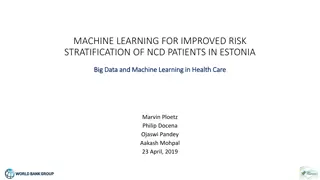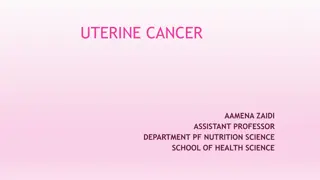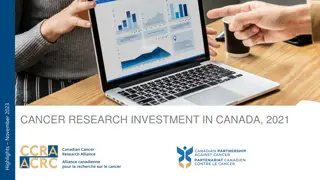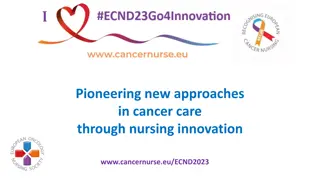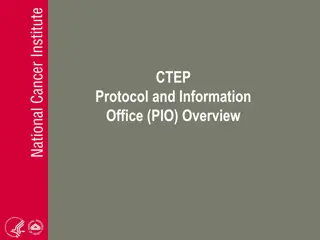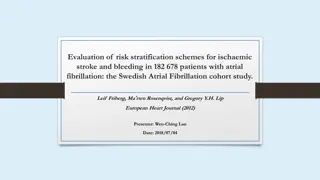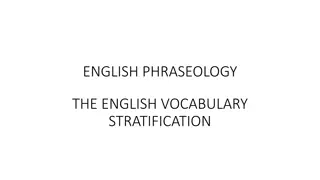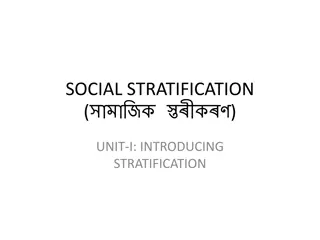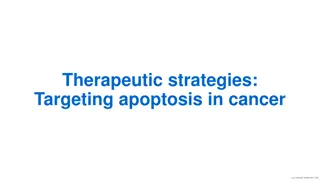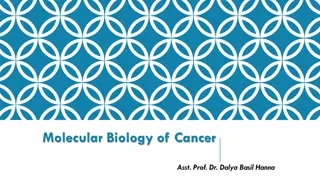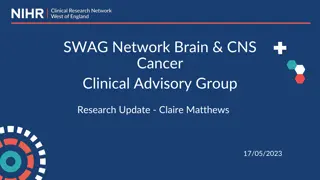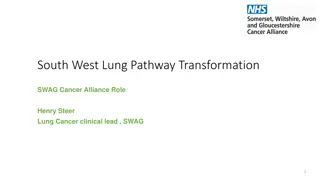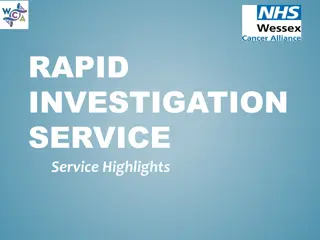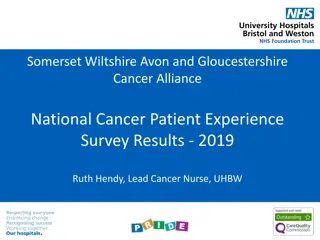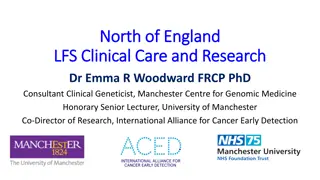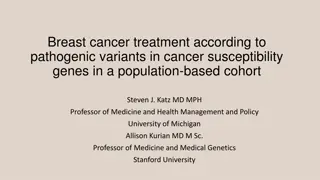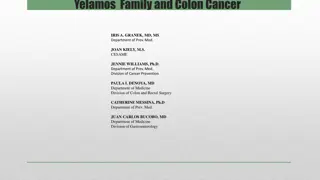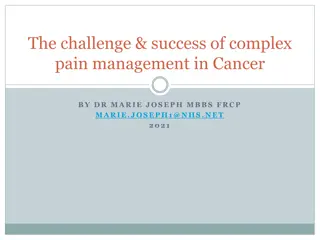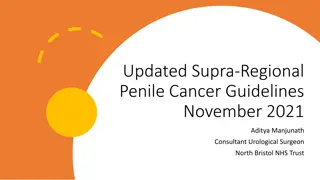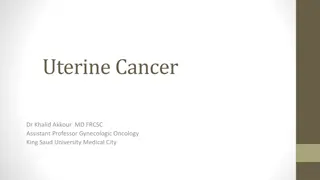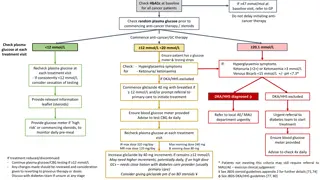Understanding Dynamic Risk Stratification in Thyroid Cancer Management
Dr. Matthew Beasley, a Consultant Clinical Oncologist, discusses the importance of Dynamic Risk Stratification in managing differentiated thyroid cancer. The process involves post-treatment monitoring through stimulated thyroglobulin (Tg) and neck ultrasound at specific intervals, aiding in determining the TSH target for follow-up. Responses are classified as Excellent, Indeterminate, or Incomplete, based on various criteria, helping in differentiating low, intermediate, and high-risk patients. The British Thyroid Association and ATA guidelines provide further insights into setting Tg targets and interpretations. Additional assessments like neck ultrasound and thyroglobulin measurements using immunometric assays play crucial roles in the management of thyroid cancer.
- Dynamic Risk Stratification
- Thyroid Cancer Management
- Clinical Oncology
- Thyroglobulin Measurements
- Neck Ultrasound
Download Presentation

Please find below an Image/Link to download the presentation.
The content on the website is provided AS IS for your information and personal use only. It may not be sold, licensed, or shared on other websites without obtaining consent from the author. Download presentation by click this link. If you encounter any issues during the download, it is possible that the publisher has removed the file from their server.
E N D
Presentation Transcript
Dynamic Risk Stratification Dr Matthew Beasley, Consultant Clinical Oncologist
Setting the scene An era of individualised, risk stratified approach to management of differentiated thyroid cancer Current BTA Dynamic Risk Stratification post treatment mandates stimulated Tg and neck ultrasound at 9-12 months Applies to those who have had surgery and radio-iodine ablation Determines the TSH target for follow-up
Dynamic Risk Stratification Excellent Response Indeterminate Response Incomplete Response All of the following Suppressed and stimulated Tg < 1ug/l* Neck US without evidence of disease Cross sectional imaging and/or nuclear medicine imaging negative (if performed) Any of the following Suppressed Tg < 1ug/l and stimulated Tg 1 and < 10ug/l* Neck US with non specific changes or stable sub centimetre nodes Cross sectional imaging and/or nuclear medicine imaging with non-specific changes, although not completely normal Any of the following Suppressed Tg 1ug/l or stimulated Tg 10ug/l* Rising Tg Persistent or newly identified disease on cross-sectional and/or nuclear medicine imaging Low risk Intermediate risk High risk British Thyroid Association Guidelines 3rd Edition Clinical Endocrinology Volume 81. Issue s1. Pages 1-122 July 2014
ATA Dynamic Risk Stratification ATA Guidelines Haugen BR et al (2016) Thyroid 26 (1) Suppressed Tg target <0.2 ng/L Rising anti-Tg Abs implies multiple readings?
Neck ultrasound Asking our radiology colleagues to make a response assessment on ultrasound Operator dependent
Thyroglobulin (thyroid cancer blood tumour marker) Thyroid Follicle TG + iodine + tyrosine Colloid 90% T4 10% T3
Thyroglobulin measurement 3 main methods Immunometric assay 1. Radio-immuno assays first used in the 1980s 2. Novel highly sensitive 2 antibody sandwich immunometric assays introduced widely over the last decade Capture Ab Signal Ab Y Y TG 3. Liquid chromatography-tandem mass spectroscopy
Thyroglobulin assays Assay RIA Immunometric LCMS Functional sensitivity (ug/L) 1.0 0.1 1.0 Antibody interference Resistant Problematic Absent Between method concordance Problematic Problematic Problematic Cost ++ + +++ Clinical evidence of utility ++ ++ ? Radio-activity + - -
TSH target Excellent response Indeterminate response Incomplete response Low normal range (within normal range but</=2.0) 0.1-0.5 <0.1
Excellent response achieved in 86% 91% of ATA low-risk patients risk of recurrence over 5 10 years of follow-up ranged from 1% to 4% (median 1.8%) in patients who had an excellent response to therapy by 6 18 months after total thyroidectomy and RAI remnant ablation (20 retrospective studies) intermediate-risk patients who achieve an excellent response, risk of recurrent/persistent disease decreased from 36% 43%(predicted by initial ATA risk stratification) to 1% 2% (predicted by response-to- therapy reclassification) The few high-risk patients that achieve an excellent response to therapy also have subsequent recurrence rates in the 1% 2% range ATA Guidelines Haugen BR et al (2016) Thyroid 26 (1)
Indeterminate response 12% 29%of low-risk, 8% 23%of int-risk and 0% 4% of high-risk 15% 20% will have structural disease identified during follow-up ATA Guidelines Haugen BR et al (2016) Thyroid 26 (1)
Incomplete response Biochemical incomplete response Biochemical incomplete response in 15-20% of patients At least 30% spontaneously resolve to no evidence of disease 20% achieve no evidence of disease after additional therapy Up to 20% develop structural disease (<1% disease specific death) Structural incomplete response 2% 6% low risk, 19% 28% int risk, 67% 75% high risk 50% 85% continue to have persistent disease despite additional therapy Disease specific death rates as high as 11% ATA Guidelines Haugen BR et al (2016) Thyroid 26 (1)
Non-stimulated sensitive Tg assays to define an excellent response Author/Year Patient No. Time of assessment post ablation Tg cut-off (ng/mL) Recurrence rate Malandrino (2011) 425 8-18 months <0.15 0% low risk, 1% int risk and 2.7% high risk Brassard M (2011) 589 3 months <0.27 1.5% Smallridge (2012) 163 1.8 years <0.1 4.3% low/int risk Gionvanella (2009) 185 6 months <0.2 (and normal US) 1.6% low risk Good negative predictive value
Position statement from international consensus panel 2012/2013 an undetectable Tg value using a highly sensitive assay is associated with an adequate sensitivity and negative predictive value to obviate the need for measuring TSH-stimulated Tg concentrations. but detectable basal highly sensitive Tg level (i.e. between 0.1 and 1ug/L) can only be considered disease free after a negative TSH- stimulated measurement. As most patients low-risk DTC data on patients with intermediate and high risk tumours are less robust Giovanella et al (2014) Eur J of Endocrinol 171:33-46
Current algorithm Neck US and usTg at 9-12 months Neck US no evidence of disease Neck US shows residual disease Neck US equivocal or anti-Tg Abs usTg < 0.1 ug/L usTg 0.1 but <1.0 ug/L usTg 1.0ug/L sTg sTg 1.0ug/L sTg <1.0ug/L Indeterminate response Excellent response Incomplete response
Current algorithm Neck US and usTg at 9-12 months Neck US no evidence of disease Neck US shows residual disease Neck US equivocal or anti-Tg Abs usTg < 0.1 ug/L usTg 0.1 but <1.0 ug/L usTg 1.0ug/L sTg ? sTg 1.0ug/L sTg <1.0ug/L Indeterminate response Excellent response Incomplete response


